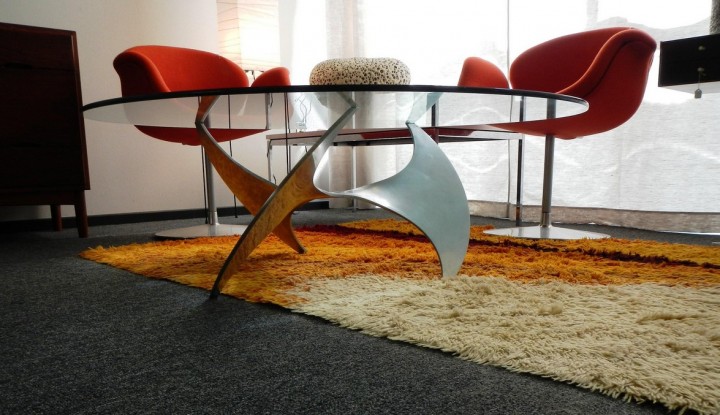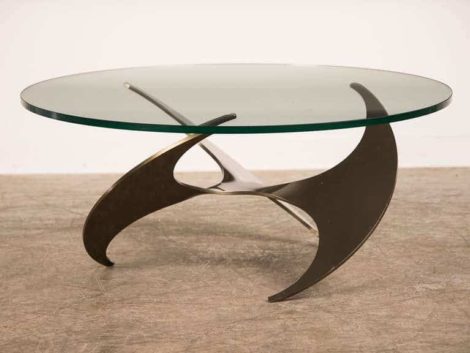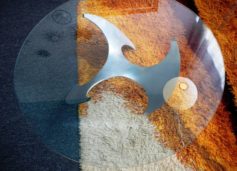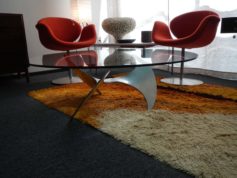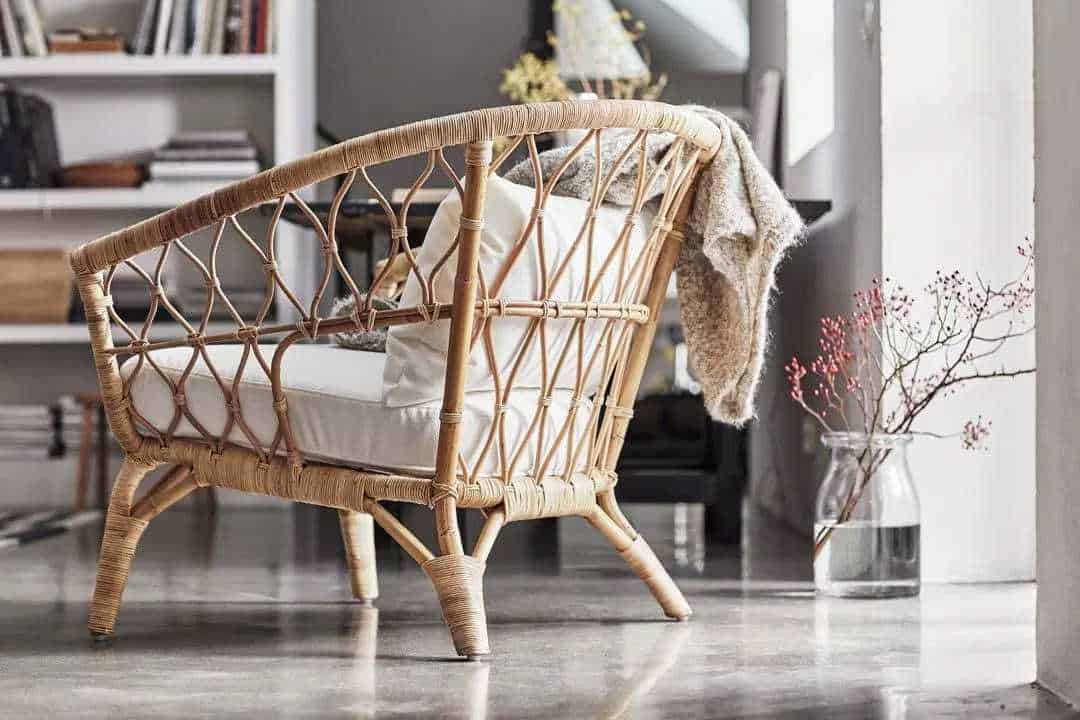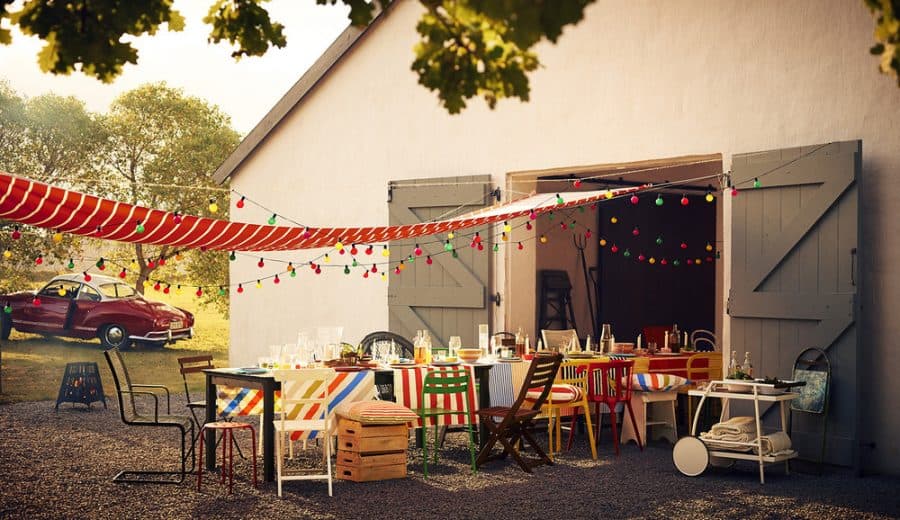As most of you know, when it comes to vintage furniture, finding the perfect item for your home can be a hassle. Everyone has that very one piece in mind they’ve hunted forever for, or at least have the feeling that there is something out there waiting for them, that will make their interior stand apart.
There are thousand of great stories to share about the quest for that missing piece. And I’ve decided to share one with you today, that particularly shaped the way I now approach flea market & antiques shopping.
I have also included at the end of this article, my very own 7 quick tips to finding your own diamond in the rough at the flea market.
A diamond in the rough: Knut Hesterberg’s A Propeller Table
When I first moved to my Parisian apartment a few years ago, I had every single piece of furniture I needed: a subtle mix of vintage, family antiques and… IKEA (Yes, I swear they perfectly get along!). But I was missing one thing: a coffee table for the living room. And since I did not want to settle for any coffee table, I decided to wait. And wait…
In the end, I spent a year with that missing piece in my living room. I mean a full year (which is pretty long for someone who craves for that precise item – and pretty bad from a Feng shui perspective). I managed to wait all that time, because I exactly knew what I wanted: something like the Noguchi accent table, but more… original. Finding a genuine Noguchi accent table would not have been a problem. The issue was that it would have been an easy and questionable pick (particularly among many of my antique-dealers friends in Paris), and some kind of quickly giving up on a challenging, but yet beautiful quest. And this coffee table would become some day my Holly Grail.
I got tempted a few times to settle for a random coffee table “in the meantime” (“in the meantime” is a dangerous concept, as it sneakily transforms into “forever”). I even questioned the sanity of my very own approach. But I stood fast. And it eventually paid off.
On one Saturday morning of April, I drove a group of friends to the flea market in Porte de Vanves (my favorite flea market spot in Paris: it offers a lot of quality items, a broad variety of vintage furniture and it’s very, very affordable). I bailed them out near the entry of the flea market, so they could start their tour, while I would park the car in the meantime. After five minutes, a friend called to tell me that I should come right away and check that coffee table she had found. She was not sure exactly what it was, but it nonetheless looked like that Noguchi accent table but… cooler. I did a U turn, drove back to the place where I dropped them, curbed in a squeal of tires, and left the car running to reach my friends waving to me in the distance.
I knew they had found something pretty unique, merely judging by the group of other customers who had been gathering around them, impatiently waiting for my friend to let go the object she was firmly holding. As I got closer, I noticed the incomparable shape of an authentic Knut Hesterberg A Propeller Table from the 1960s. In this instant I knew this was it, that my quest was over and that I wanted this coffee table whatever the price was. My heart missed a beat when I heard that the merchant wanted 100€ for it, but that “it was negotiable” (a genuine A Propeller Table is easily priced 10 times as much as what this merchant wanted for it that day). I gave him his 100€, shook his hand, cracked a joke and headed back to the car with my precious cargo, leaving a group of disappointed groaning customer (which by then, had grown twice its size).
It has been 6 years now since this crazy adventure. And the Knut Hesterberg A Propeller Table has been following me since then. I moved from Paris to Linz, Vienna, and Brussels, and it’s still here, acting as a reminder of the fact that determination pays off.
Conclusion
In the end, what is great about flea markets is that you never know what you will find; that some days you’ll go back home empty-handed or frustrated for having missed a great deal by a few seconds. But other days, some finds exceed your expectations! I’ve been slowly furnishing my home, with hand-picked items I found at the flea market. And in the end, I made this thought, my philosophy of life: “The most valuable items are not those that you think will be valuable for resale. The really priceless things are the objects you personally love.”
How about you? Did you already experienced a similar story? Was this perfect piece of furniture or item hidden in a corner? Way underpriced? A diamond in the rough? We’d love to hear how you styled that piece once you got it home and hear your “best find” story! Please use the comment section below to share your story, or drop us a message! We’ll publish the most interesting stories!
7 quick tips to finding your own diamond in the rough at the flea market
Go to bed early the night before: Getting a good night of sleep is indissociable from a successful day at the flea market. Of course this won’t guarantee that you will find something of your interest that day, but it will undoubtedly help you stay focus on your search. In my own experience, 100% of the time I showed up early and tired at the flea market, I ended up the day empty-handed.
Show up early at the flea market: “The early bird gets the worm”. And this is not only a say! Like in the Knut Hesterberg’s “A Propeller Table” story, showing up early at the flea market increases the probability of scoring a great deal. The best things will go first, and you can bet that if it’s beautiful and/or worth something, there will be someone to pick it up! And always try and show up at least 40 minutes ahead of the official opening time: quite often (particularly in the case of open-air flea markets) the market premises are “unofficially” accessible before the general opening, while merchants are still unboxing their wares. This is one of the best time to find hidden gems.
Stay open minded when shopping: If you show up at the flea market with a too specific idea of what you’re looking for, chances are that your mind will be kept busy looking for this specific item. And you will “blindly browse” the stalls, missing on other great opportunities. So, go freestyle! Try and picture what a specific item would look like out of its flea market context. This require some practice and a bit of imagination. I’ve missed a few opportunities in the past, because I wasn’t able to focus on this, and realized later how great this object would have looked in my appartment.
When you found it, grab it: … and don’t let go! Merely looking at something on a stall is not enough to be considered as way to claim it. If you like it, you must hold it in your hands. This is a way to prevent other people from taking it from you. I’ve even seen people go crazy and take things from other people’s hand! So when you find something you’re interested in, grab it, hold it firmly, and do not let go!
Know your flea market: The professional antique dealers and the savvy flea market enthusiast each have their own way of looking for hidden treasures. If the first mostly relies on his educated flair for the rare and valuable, the second can overcome this weakness by “knowing” his flea market & merchants. Maintaining a good relationship with merchants, often means being able to get a sneak preview on his wares before anyone else, and a secure a great price. If you’re not familiar with the flea market you’re visiting, do a quick tour first to get an overview of the place before browsing a stall in details.
Stroll the flea market up and down: This may sound like a cheap tip, but I guarantee that you won’t see the same things from two different perspectives. That’s why it is always wise to stroll at least twice a flea market venue. You might even be surprised how different a market looks like when browsed from a new angle.
Educate yourself: Most flea market & antiques merchants I met, started their career out of passion for antiques, vintage and History. They once were teachers, civil servants, bricklayers & tilers, programmers, unemployed or CEOs. Actually, not so many of them had a relative in the business or studied Art History. They decided to take the leap into the antiques world, the day they realized they really were knowledgeable about a specific antiques & vintage related topic. And even those who are considered as the best in their discipline, pursue their self-made education (if you don’t see an antiques dealer haggling or groaning, you’ll see him/her reading a book about antiques). Even if you don’t turn your passion into your business, being knowledgeable about something will be profitable to yourself. This something can be furniture, militaria, crockery, industrial design, designer clothes, vintage accessories, paintings, photography. You name it. After all, there’s something for everyone in the vast antiques & vintage world.

